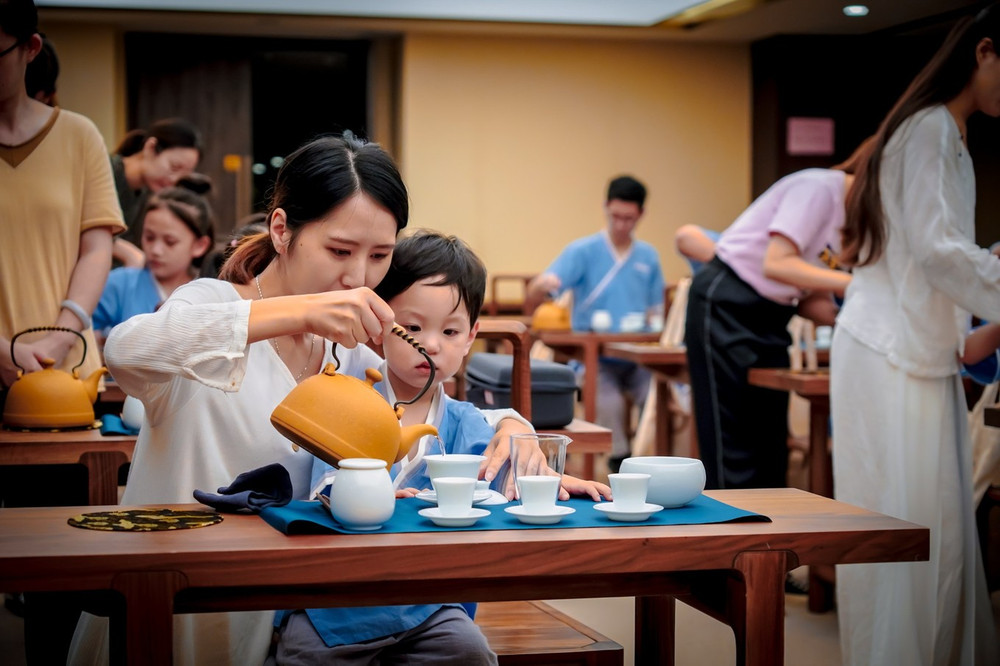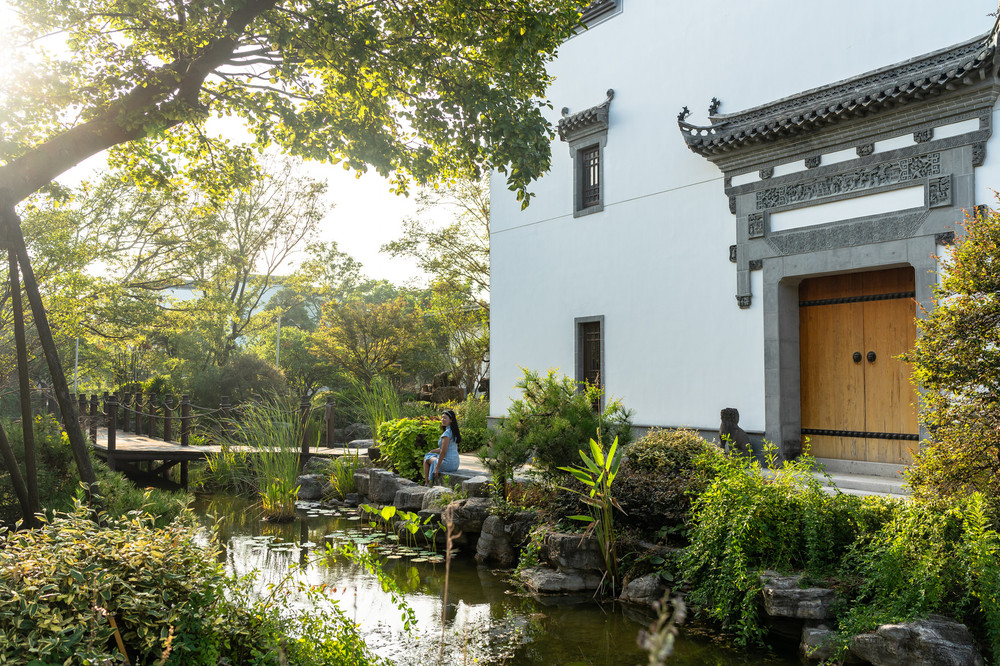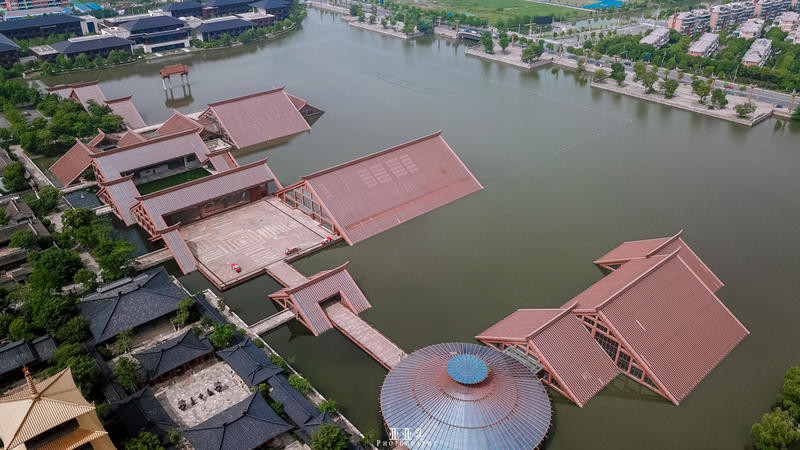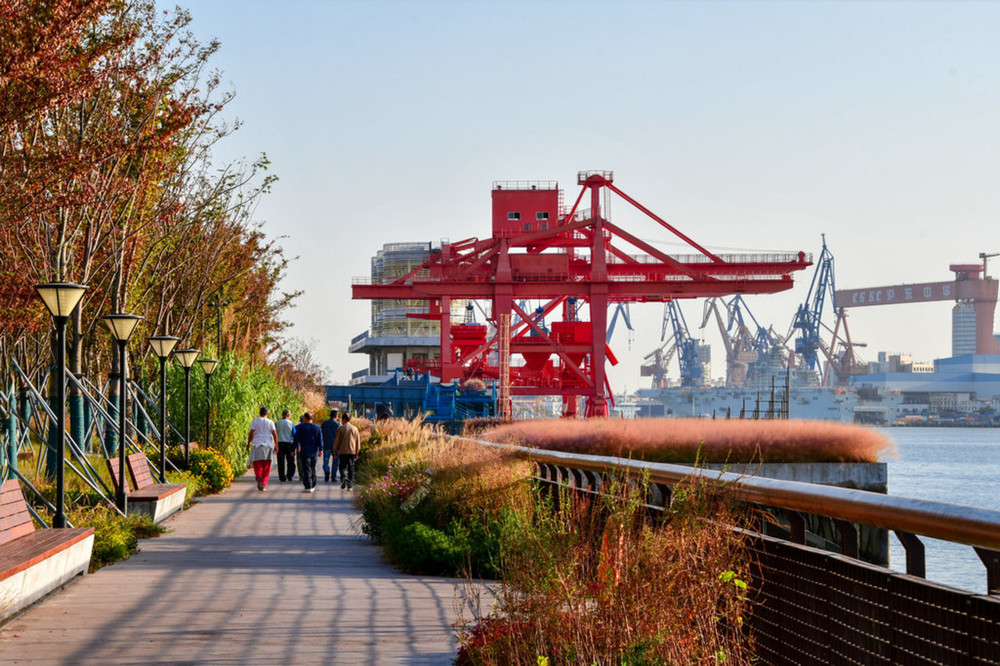Duration: 1 day. Time: July. Per capita cost: 30 yuan. With whom: Friends. Ways to play: Photography, self-driving, humanities, weekend trips.
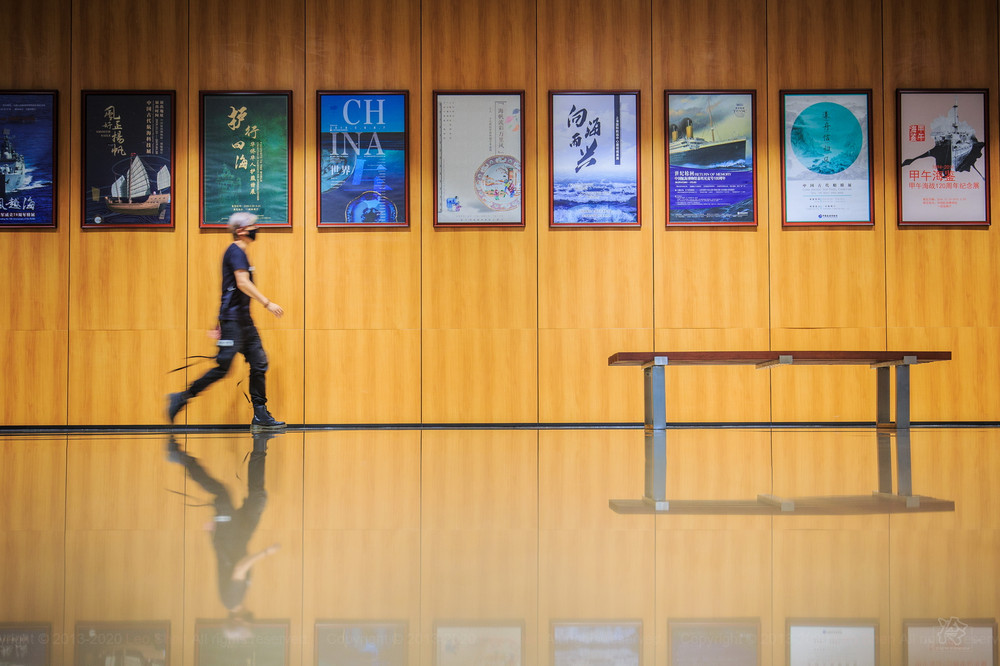
The author visited these places: China Maritime Museum, Shanghai Dishui Lake, Donghai Bridge, Paramount. Posted on July 14, 2020.
Do you know the origin and evolution process of China’s maritime technology? Do you want to have a look at the cultural relics related to navigation throughout history? As one of the top-ranked museums for parent-child outings in Shanghai, what are the outstanding features of the China Maritime Museum? Seeing is believing. Today, let me take you to experience the special features of this largest and highest-level comprehensive maritime museum in China.
The China Maritime Museum is currently the only national-level maritime museum in China established with the approval of the State Council. Address: No. 197 Shengang Avenue, Nanhui New City, Pudong New Area.
Transportation information:
Public transportation: Take Metro Line 16 and get off at Dishui Lake Station. Then take Bus 1096 and get off at Huanshi West Second Road, Shengang Avenue Station. Walk to reach the destination.
Self-driving: Outer Ring Road S20 (towards Pudong Airport) – S2 Expressway (towards Donghai Bridge) – Exit at Lingang New City and drive straight along Shengang Avenue to the China Maritime Museum. The whole journey takes about 80 minutes.
Special note: Under the epidemic situation, the China Maritime Museum has taken measures to limit the flow of people. It can receive a maximum of 4,000 visitors per day and 1,000 visitors instantaneously. Visitors need to make a real-name reservation in advance through the ‘Shanghai Tour Code’. After arriving at the museum, show the ‘reservation code’ and the green ‘Shanghai Health Code’ on the official website’s public account to enter the museum.
Maybe many people will initially confuse it with the China Marine Museum because the two are very similar in wording. In fact, there is a big difference. The China Maritime Museum visited today is a national-level museum completely themed on ‘navigation’ and based on ‘museums’. The addition of the words ‘China’ before the Maritime Museum is also sufficient to show that its scale and content are currently the largest and most complete exhibition hall with the theme of navigation in China.
Travel guide: The museum has three floors and is divided into six exhibition halls: maritime history, ships, navigation and ports, maritime affairs and maritime safety, seafarers, and military navigation. There are also two special exhibition areas: fishing boats and fishing, and maritime sports and leisure. There are also exhibition halls such as an planetarium, a 4D cinema, and a children’s activity center. However, most of the exhibition halls are distributed on the first and second floors. There is an exit on each floor. The entrance is located in the middle of the second floor. The recommended tour order is to take the escalator down to the first floor to start the visit after entering.
The museum provides free guided tour services. Usually, there is one guided tour in each exhibition hall in the morning and afternoon. It is recommended to follow the guide’s explanations and visit in turn. The quality of the guides here is very high. They can not only easily explain most of the maritime history but also are familiar with all the exhibits in the museum.
After entering the museum, pay attention to the notice board for lecture times or consult the staff. If you miss the free lecture time, you can rent an audio guide (10 yuan per unit) at the service center at the entrance. If you hire a paid docent, it costs 50 yuan per hour (in Chinese). The museum is open to the public for free on China Maritime Day, July 11 every year.
First impression: The external shape of the museum is very conspicuous. The external shape of the entire exhibition hall is like a large sailing ship, which is very in line with the theme of navigation and also has a strong modern art atmosphere. Compared with the high land prices in the urban area, the space here is extremely large. The float on the square in front of the museum looks familiar. Yes, it is the ‘Striving Shanghai’ float representing Shanghai at the ceremony commemorating the 70th anniversary of the founding of the People’s Republic of China in 19. The float is mainly shaped like a 10,000-ton LNG giant ship, symbolizing Shanghai’s sailing through wind and waves and continuing its long voyage… The float model in front of us is the one on display. When viewed up close, it feels extremely well-made and stunning.
Exchange tickets at the ticket office at the entrance. After scanning the code and entering the venue, the first thingThe Fuchuan in front of us is an important witness of the ancient Maritime Silk Road. It is also one of the standard ship types used in the fleet of the great navigator Zheng He’s voyages to the Western Seas. The treasure ship is replicated according to ancient shipbuilding techniques and is basically made of wood. Tourists can board the deck to experience the charm of this ancient large ship, feel the advanced shipbuilding technology of ancient China, and understand the navigation history of Zheng He’s voyages to the Western Seas in the Ming Dynasty.
It is said that because the construction of the treasure ship was completely in a 1:1 ratio at the beginning, this ship is a Fuchuan that can truly sail in the sea, rather than just a model. Since it is called a treasure ship, there must be its subtleties. Boarding the ship from the entrance on the first floor, one can see that the ship’s body is indeed very large. The tall mast is almost at the top. The docent introduced that the deck of the ship is deliberately not tightly fitted because there are many winds and waves during sea voyages. This is more conducive to the rapid drainage of rainwater and waves, thereby keeping the deck dry. In the room at the bow, Mazu is enshrined. This is also the sea god that must be worshipped by fishing boats in Fujian and Guangdong when they go to sea. There is still a lot of space in the stern that is divided into grids. It turns out that it is used to place poultry. In order to ensure the nutritional balance of the crew during long-term voyages at sea, it has to be said that although seemingly a simple merchant ship, there are really many mysteries contained in it. Although for safety reasons, the cabin and bow are not truly open for sightseeing, but one can still feel the wisdom and courage of ancient shipbuilders.
Behind the treasure ship are models of some of the most famous passenger ships and warships at all times and in all countries, including China’s aircraft carrier Liaoning and the world’s largest cruise ship Titanic. Whether you are interested in navigation or not, at this moment, you will also be infected by their existence. The models are extremely well-made, and even the pilots and fighter jets on the aircraft carrier are vivid.
The main exhibition halls on the first floor include the Navigation History Hall, the Ship Hall, the Seamen Hall, and the special exhibition area for fishing boats and fishing. Here, you can see graphic and video introductions about Chinese navigation history. The most worthwhile one among these is undoubtedly the Navigation History Hall. This hall is divided into ancient, modern, and contemporary exhibition areas with time as the main line. The history hall takes technology as the secondary line and隐性 line. Shipbuilding and navigation technologies such as buoyancy crossing water, canoes, wooden boats, sails, oars, sculls, rudders, and compasses are developed in parallel with the main time line, allowing tourists to have a deeper understanding of the invention and evolution process of Chinese navigation technology. The dim lighting, exquisite exhibits, and spacious passages give people an illusion of a time tunnel. And the exhibits in this part are also the most precious and expensive in the exhibition hall.
Spring and Autumn Great Wing Warship: Made of 3 kilograms of pure gold, engraved with 94 miniature soldiers, 43 cm long and 16 cm high. The Great Wing Warship is a kind of water combat ship in ancient China. This ship is made entirely of pure gold. On such a small ship, soldiers and oarsmen are respectively loaded on the upper and lower decks. Even the details of the combat bows and arrows can be seen clearly. Regardless of the cost, just considering its historical and artistic value, it is a true priceless treasure.
Of course, when it comes to navigation, the story of Zheng He’s voyages to the Western Seas is inevitably mentioned. Here, the route and experiences of Zheng He’s seven voyages to the Western Seas are expounded by combining historical records and videos. And many exhibits are also genuine items collected from the treasure ship salvage. It is worth mentioning that even now, Zheng He himself is quite handsome and has a full temperament of a “rich second generation gentleman”. Of course, his contributions and value to China’s navigation industry cannot be measured by money at all. It is also very regrettable that he finally died of illness during the seventh voyage.
In the museum, there is “The Great Ming Unified Map”, which is currently the largest, oldest, and best-preserved ancient world map known in China. This map was drawn more than 100 years earlier than Europeans drew Africa. There are only four copies of this map’s replica in the world. The one collected by the China Maritime Museum is one of them. The other three are respectively collected in the First Historical Archives of China, South Africa, and Japan, which shows the rarity of this### The Yidun Ship: A Milestone in China’s Maritime History
In October 1872, a significant event marked the beginning of China’s modern national shipping industry. The China Merchants Steam Navigation Company acquired the Yidun ship from the Peninsular and Oriental Steam Navigation Company. This ship holds a dual distinction as China’s first merchant ship and the first steam-powered merchant ship to sail on international routes. The Yidun’s maiden voyage not only initiated China’s ocean international trade but also hastened the development of the country’s foreign trade and commercial freight transportation capabilities. The ship model, reflecting the original’s exquisite craftsmanship, stands as a testament to this historic moment.
### Modern Navigation and Maritime Exhibitions
The modern navigation area is a treasure trove of maritime history, showcasing a variety of well-known warships and merchant ships that have been pivotal in territorial expansion and trade across various nations. Wooden boats that participated in river crossing campaigns are also on display, alongside detailed exhibits of China’s most advanced icebreakers, submarines, and ten-thousand-ton ships. These displays underscore the critical role of navigation in a nation’s sovereignty, trade, and economy.
### The Ship Pavilion: A Showcase of China’s Maritime Fleet
Opposite the Navigation History Museum stands the Ship Pavilion, highlighting the types of ships primarily used in China’s maritime transportation and operations at sea. A notable mention is the thermal suit, a vital safety equipment for maritime emergencies, akin to life jackets, which are essential to prevent the loss of body temperature after falling into water.
### The Fengqing Model: A Glimpse into Early Chinese Ocean-Going Cargo Ships
A large model of the early Chinese ocean-going cargo ship, Fengqing, offers visitors a unique opportunity. The model has a section cut open, allowing for an intimate observation of the ship’s internal structure, a sight that is not to be missed.
### The Mariner Pavilion: A Revitalized Experience
The Mariner Pavilion, after renovation and upgrading, has ‘set sail’ in a brand new appearance. It not only displays the work and life of mariners at sea but also reviews the precious maritime literature of the past century. The 3D navigation simulator, which realistically simulates the ship’s cockpit, is an instrument used by mariners to train their driving skills and capabilities. Visitors can also experience the feeling of being a captain in the navigation simulator.
### The Second Floor: A Hub of Naval History and Knowledge
The second floor houses the Navigation and Port Pavilion, Maritime and Marine Safety Pavilion, Military Navigation Pavilion, and the Navigation Sports and Leisure Special Exhibition Area. Here, visitors can learn about the construction history of the Chinese Navy, ports, and maritime rescue, as well as view models of warships, naval flags and uniforms, and actual ship-mounted artillery.
### Military Navigation Pavilion: Warships and Aircraft Carriers
Most people’s initial understanding of navigation or warships comes from film and television works. The Military Navigation Pavilion on the second floor highly reproduces models of many distinguished warships and aircraft carriers from World War I and World War II, including models of the ‘Anshan’ destroyer, ‘Jinan’ missile destroyer, and ‘Ohio’ missile nuclear submarine. These models, along with various warship models, naval flags, and naval uniforms, provide a comprehensive understanding of Chinese naval knowledge.
### Maritime and Marine Safety Pavilion: Rescue, Salvage, and Anti-Piracy
The Maritime and Marine Safety Pavilion displays maritime rescue, salvage, and anti-piracy topics through physical objects, models, multimedia, and electronic maps. Various lighthouses, symbols of sovereignty, are also featured. The everyday contact with Chinese maritime patrol boats during cruises represents the sovereignty of national territorial waters.
### Interactive Exhibitions and Dining Options
To mitigate the monotony and aesthetic fatigue that can arise from extended museum visits, each exhibition hall incorporates interactive areas designed to engage visitors through 3D, visual, light and shadow, and hands-on experiences. The museum’s first-floor restaurant offers affordable meals, making it a convenient dining option for families who do not wish to leave the premises. Patrons are also welcome to bring their own food, as there is a dedicated rest area for enjoyment. Adjacent to the museum, a café with a nautical theme provides a perfect spot for a break after exploring the exhibits.
### Cultural and Creative Gift Area: A Nautical Souvenir Haven
During the visit, one often passes through a square space filled with the much-anticipated cultural and creative gift area. Here, visitors can select a variety of nautical-themed souvenirs. The range and style of gifts echo the aesthetic of the Forbidden City Museum, yet they also showcase distinct maritime-themed creativity, offering rare items not commonly found in the market. Even exquisite ship models are available for purchase here, which are more delicate and detailed compared to assembly toys like LEGO, making this an essential shopping spot for collectors.### Special Recommendation: The 4th Maritime Lifestyle Festival
Coinciding with the 10th anniversary of the China Maritime Museum’s opening, the museum has organized numerous temporary and special exhibitions. While some interactive sections, the planetarium, 4D cinema, and children’s activity center remain closed due to the pandemic, the ‘Maritime Lifestyle Festival’ is particularly appealing as it opened this week.
**Festival Highlights:**
– **10th Anniversary Celebrations:** The festival aligns with the museum’s 10th-anniversary celebrations, offering free trials of various activities that both adults and children can enjoy.
– **Travelogue Stamp Collection:** Collecting stamps from the travelogue allows visitors to exchange them for a commemorative stamp marking the decade.
– **Interactive Performances:** The festival features interactive performances such as ‘Signal Flag Demonstrations,’ ‘Sailor Knot Interactions,’ and ‘Maritime Children’s Plays.’
– **Challenges and Experiences:** Participants can engage in challenges like the Navigation Challenge, VR Rowing Challenge, Remote-Controlled Boat Experience, and Maritime Bottle-Throwing Ceremony.
– **Commemorative Badges:** Earn a commemorative badge for the museum’s 10th anniversary.
– **Free Lottery:** There are mystery gifts available through a free lottery, which can be entered using a mobile phone number.
– **Cost-Effective Summer Fun:** All games are free to enter for both adults and children, making this arguably the most cost-effective exhibition for children and teenagers during the summer vacation.
### Special Recommendation 2: ‘Ports for the City, Cities Prospering with Ports’ Special Exhibition
Currently in the first temporary exhibition hall, there is a special exhibition titled ‘Ports for the City, Cities Prospering with Ports.’ The exhibition begins with a neon-lit street, integrating elements of civic life, culture, and economy, creating a nostalgic display.
**Exhibition Highlights:**
– **Historical Significance:** During the reigns of Emperors Jiaqing and Daoguang, Shanghai saw a fleet of over three thousand five hundred sand ships, earning the port the accolade of ‘Hometown of Sand Ships.’
– **Shanghai’s Maritime Development:** From the old city enclosures to the modern Bund, the maritime development of Shanghai’s port has carried not only history but also the sentiments and aspirations of the people of Shanghai.
– **Cultural Artifacts:** The rickshaws we are familiar with were imported from Japan and can still be seen on the streets of Tokyo and Kyoto. The cheongsam, originally a Manchu women’s garment, was influenced by the West and has evolved into a more fitted and fashionable attire suitable for young women today.
– **Familiar Landmarks:** Landmarks familiar to Shanghai residents, such as the Paramount Ballroom and the Shanghai Railway Station, can also be found here.
– **Free Access:** The exhibition is currently open to the public for free until the end of the year.
**China Maritime Museum Ticket Discounts:**
– **Adult Tickets:** Reduced to 30 yuan per person.
– **Student and Teacher Tickets:** Reduced to 15 yuan per person.
– **Senior Tickets (Aged 60 to 69):** 10 yuan per person.
– **Children (Aged 6 and under or under 1.4 meters in height):** Enter for free.
Visiting the China Maritime Museum is not only an educational experience for both adults and children but also offers a deeper understanding of Shanghai’s past and present. Each encounter is like the first, looking forward to meeting you on our next journey.






